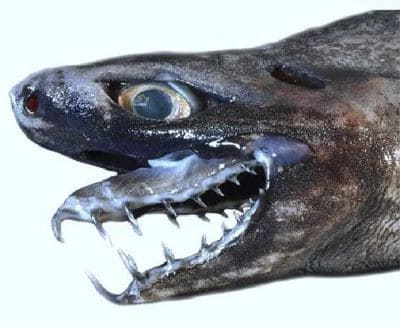Home › Sea Life Facts › Marine › Vertebrates › Sharks › Viper Shark
Interesting Facts about Viper Sharks
[Dogfish Phylum: Chordata] [Class: Chondrichthyes] [Order: Squaliformes] [Family: Etmopteridae]
Despite being one of the rarest species of shark, and rarely seen by humans, the viper dogfish actually exists - and so does its extendable jaw with razor sharp teeth.
This guide contains facts and interesting information about viper sharks (vipertooth dogfish), including where they live, what they eat, and how they reproduce.
Viper Shark Facts: Habitat and Distribution
By and large, the northwestern Pacific Ocean is the best region to find specimens of the viper dogfish, especially:
- Kii Peninsula
- Leeward Hawaiian Islands
- Ogasawara Islands
Through a procedure known as diurnal vertical migration (DVM), the species shifts between continental slopes around 300 metres deep in the daylight to shallower waters around 150 metres at night.
Pro Tip: Another section contains an extensive list of oceanography terms A-Z with simple explanations of words used in marine biology.
Viper Dogfish Characteristics and Behaviour
Like most of the shark phylum, Trigonognathus kabeyai has a cylindrical slender body with a short, and somewhat blunted, snout and narrow, egg-shaped spiracles. Their eyes are large and ovalic and their nostrils look like vertical slits.
Even so, one of the standout features of the viper dogfish is the way it can protrude its long narrow jaw, and fang-like teeth, from the head.
Viper Shark Size
Even though the female viper shark can grow to fifty four (54) centimetres long (21 inches), the male tends to be smaller (around 47 centimetres). It would be rare for any of the genders to weigh more than one kilogram (about 2 pounds).
It is a menacing looking, black fish. But, their fins are small, rounded, and extremely thin. Furthermore, the first dorsal spine is shorter than the second, and there is no anal fin.
Nonoverlapping dermal, diamond shaped denticles cover most of the skin. Even though it is more of a common feature in deep sea dwelling invertebrates (e.g. cephalopods), these markings actually contain light-producing glandular organs (called photophores).
Pro Tip: Another section explains why humans are the deadliest animals and why sharks do not kill most humans - nowhere near!
What Do Viper Dogfish Eat?
The viper shark dogfish (T. kabeyai) extend their jaws and teeth to grab and impale their prey. But, unlike many dogfish sharks, the feeding mechanism of this typical carnivore means they will actually swallow large chunks of meat whole.
 For the most part, the viper dogfish diet will include:
For the most part, the viper dogfish diet will include:
- Crustacean animals
- Myctophids (lanternfishes)
- Osteichthyes (bony fishes)
- Sea shrimp species
Interesting Fact: The viper dogshark is able to consume fish that are almost half their own body length.
Viper Sharks Reproductive Process
Trigonognathus kabeyai give birth to live young via a process known as viviparity.
During gestation, the developing embryos get their nourishment from the yolk. Despite that, an average litter size is thought to be less than twenty five (25) pups.
Dogfish Predators and Threats
Even though they have very little economic value, sawtooth viper dogfish sometimes get caught "accidentally" in bottom trawls, and as a consequence of seine fishing.
Furthermore, some of the known predators include several marine ray-finned fishes, such as the sickle pomfret (Taractichthys steindachneri) and the bigeye tuna (Thunnus obesus).
Important: Accurate information about viper dogfish lifespan is sketchy, but the spiny dogfish is closely related and they can live for over forty (40) years. An assessment from the IUCN Red List of Threatened Species in June 2019 shows the conservation status of the viper dogfish is "Least Concern" (LC) with a "Stable" population trend.
Related Information and Help Guides
- Bull Shark (Carcharhinus leucas) Reproduction and Life Cycle
- Interesting Facts about Ghost Sharks (Chimaeriformes)
- Horn Shark Fun Facts and Information (Heterodontus Francisci)
Note: The short video presented by "STRANGELAND" contains more viper dogfish facts with some little-known information about the dogfish scientific name Trigonognathus kabeyai.